Friday, June 02, 2006
Æ20, Ephesus in Ionia, Gallienus, BMC 379
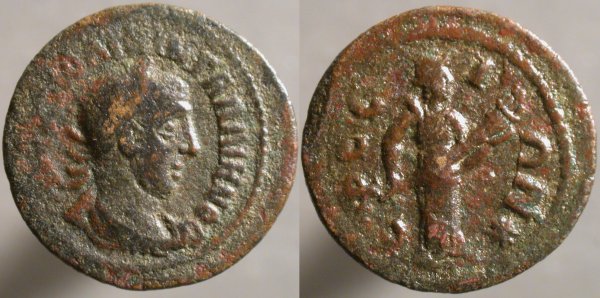
[...] ΛIKIN ΓAΛΛIHNOC, Laureate draped bust right | EΦEC_I_ΩN*, Artemis standing right holding long torch in both hands.
Roughly the same size as Tuesday's coin, though not as well-preserved, this is from the more widely-known city of Ephesus (“the best preserved classical city of the Eastern Mediterranean”.) Today the Turks hold the camel wresting championship at the site of ancient Ephesus.
The torch is an unusual but by no means unknown attribute of Artemis.
Thursday, June 01, 2006
Silvered Æ antoninianus, Gallienus, Antioch, Göbl 1629a
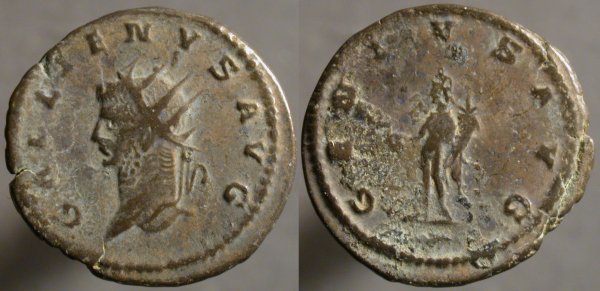
GALLIENVS AVG, Radiate head left | GENIVS AVG, Genius standing left, with right hand sacrificing from patera, with left hand holding cornucopia. Branch in exergue.
A variety of Genius coins were issued at Antioch with slight variations in legend, some with a flaming altar before Genius, others, like this, having him sacrifice directly on the ground.
Wednesday, May 31, 2006
“dating to the 10th century B.C.”
Silver denarius, L. Marcius Censorius, Roman Republic, 82 BCE, Crawford 363/1d
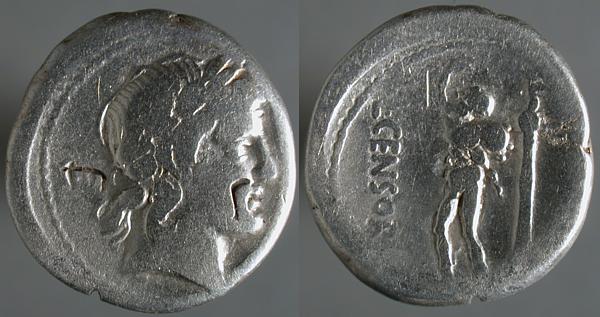
Laureate head of Apollo right | SECVRITAS REPVBLICE, Marsyas walking left with right arm raised, bulging wineskin over left shoulder. Statue of Victory on column left, L·CENSOR downward to right.
An L. Marcius Censorius is on some lists of consuls but absent from most such lists.
An article about the satyr Marsyas.
Tuesday, May 30, 2006
“Director Akbiyikoglu believes treasure is cursed”
Via A Gift For Polydektes, parts of the treasure of King Croesus, returned to Turkey by the Metropolitan Museum of Art, have gone missing.
Æ20, Mostene in Lydia, Salonina, SNG von Aulock 3031
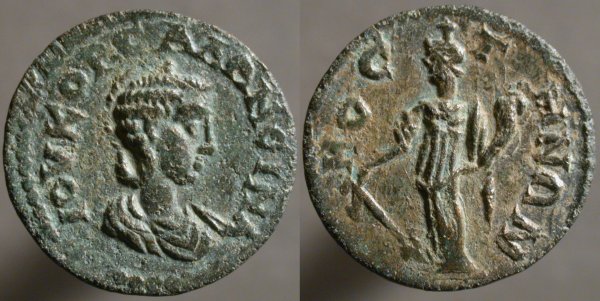
IOV KOP CAΛΩNEINA, Draped and diademed bust right | MOC_T_HN;ΩN, Tyche standing left, holding cornucopia right and rudder left.
The wife of Gallienus, Julia Cornelia Salonina Chrysogone, is most-often named simply “Salonina” on coins. “Cornelia” is added frequently, particularly early in her husband's reign. “Chrysogone” is seen on some provincial issues. “Julia”, though, I've never seen before, so I find this nicely-preserved little coin, not much bigger than a dime, particularly interesting even if the reverse is an utterly-standard standing Tyche like that used by dozens of other cities.
I don't think the location of Mostene is known, but, as the previous link says, they shared obverse dies with Magnesia ad Sipylum, so they must have been close. (A coin of Magnesia ad Sipylum was posted here.)
Monday, May 29, 2006
Billon antoninianus, Gallienus, Köln, Göbl 870f
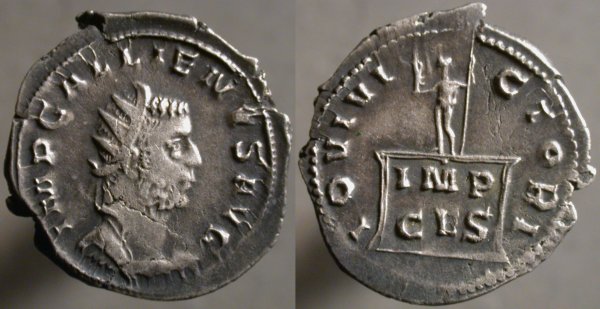
IMP GALLIENVS AVG, Radiate cuirassed bust right | IOVI VICTORI, Statue of Jove standing left, holding Victory in right hand and scepter in left, all on large pedestal marked IMP / C E S.
Here and here I posted coins with this same reverse but various obverse legends.
I can't think of a more official statement on an imperial coin than the obverse legend, with the emperor's name and titles, or their abbreviations. In addition to the three types I have at this writing, Göbl attests a single example with GALLIENVS AVG GERM V. While he shows no examples with IMP GALLIENVS PIVS AVG, that legend is roughly contemporary with these other legends and if a previously-unknown variety were to surface, that is the most likely one. I don't think these necessarily represent a series of issues while the official nomenclature was chaninging, but perhaps a time early in the reign when the fine details hand't yet been nailed down.
As mentioned in a previous post, on the reverse, "IMP / C E S" is an abbreviation for imperator cum exercitu suo, "the general with his armies."

